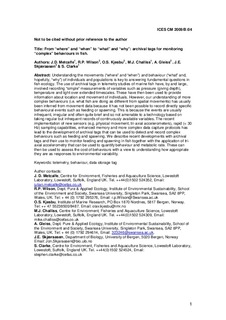| dc.description.abstract | Understanding the movements (“where” and “when”) and behaviour (“what” and, hopefully, “why”) of individuals and populations is key to answering fundamental questions in fish ecology. The use of archival tags in telemetry studies of marine fish have, by and large, involved recording “simple” measurements of variables such as pressure (giving depth), temperature and light over extended timescales. These have then been used to provide information about location and movement of individuals. However, our understanding of more complex behaviours (i.e. what fish are doing as different from spatial movements) has usually been inferred from movement data because it has not been possible to record directly specific behavioural events such as feeding or spawning. This is because the events are usually infrequent, irregular and often quite brief and so not amenable to a technology based on taking regular but infrequent records of continuously available variables. The recent implementation of new sensors (e.g. physical movement, tri-axial accelerometers), rapid (< 30 Hz) sampling capabilities, enhanced memory and more complex data capture protocols has lead to the development of archival tags that can be used to detect and record complex behaviours such as feeding and spawning. We describe recent developments with archival tags and their use to monitor feeding and spawning in fish together with the application of tri-axial accelerometry that can be used to quantify behaviour and metabolic rate. These can then be used to assess the cost of behaviours with a view to understanding how appropriate they are as responses to environmental variability.
Keywords: telemetry, behaviour, data storage tag | no_NO |
